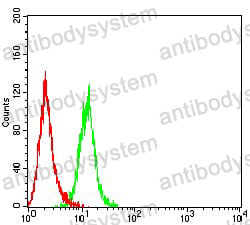Catalog No.
RHG42702
Species reactivity
Human
Host species
Mouse
Isotype
IgG1
Clonality
Monoclonal
Tested applications
ELISA: 1:10000, FCM: 1:200-1:400
Target
Growth-inhibiting gene 3 protein, Mediator of receptor induced toxicity, MORT1, FAS-associating death domain-containing protein, FAS-associated death domain protein, FADD, Protein FADD
Concentration
1 mg/ml
Endotoxin level
Please contact with the lab for this information.
Purity
>95% as determined by SDS-PAGE.
Purification
Protein A/G purified from cell culture supernatant.
Accession
Q13158
Applications
ELISA, FCM
Form
Liquid
Storage buffer
0.01M PBS, pH 7.4, 0.05% Sodium Azide.
Stability and Storage
Use a manual defrost freezer and avoid repeated freeze-thaw cycles. Store at 4°C short term (1-2 weeks). Store at -20°C 12 months. Store at -80°C long term.
Clone ID
R3S15
FOSL1-mediated LINC01566 negatively regulates CD4+ T-cell activation in myasthenia gravis., PMID:39113081
Molecular signatures in prion disease: altered death receptor pathways in a mouse model., PMID:38802941
Wilms' tumor 1 (WT1) antigen is overexpressed in Kaposi Sarcoma and is regulated by KSHV vFLIP., PMID:38190392
Impaired FADD/BID signaling mediates cross-resistance to immunotherapy in Multiple Myeloma., PMID:38129580
Lysine Trimethylation in Planktonic and Pellicle Modes of Growth in Acinetobacter baumannii., PMID:37227083
cFLIP suppression and DR5 activation sensitize senescent cancer cells to senolysis., PMID:36414711
FADD phosphorylation contributes to development of renal fibrosis by accelerating epithelial-mesenchymal transition., PMID:36281535
A transcriptomic map of EGFR-induced epithelial-to-mesenchymal transition identifies prognostic and therapeutic targets for head and neck cancer., PMID:36076232
Gap junction intercellular communication mediates cadmium-induced apoptosis in hepatocytes via the Fas/FasL pathway., PMID:35920667
Proscillaridin A Sensitizes Human Colon Cancer Cells to TRAIL-Induced Cell Death., PMID:35805980
Mechanisms in Graves Eye Disease: Apoptosis as the End Point of Insulin-Like Growth Factor 1 Receptor Inhibition., PMID:34927457
Kaempferol sensitizes tumor necrosis factor-related apoptosis-inducing ligand-resistance chronic myelogenous leukemia cells to apoptosis., PMID:34820749
Rescue of thyroid cells from antibody induced cell death via induction of autophagy., PMID:34801870
A comprehensive analysis of different gene classes in pancreatic cancer: SIGLEC15 may be a promising immunotherapeutic target., PMID:34515878
BRD4 inhibition promotes TRAIL-induced apoptosis by suppressing the transcriptional activity of NF-κB in NSCLC., PMID:34400879
Cephalosporium curvulum lectin causes mycotic keratitis by initiating infection through MyD88 dependent cellular proliferation and apoptosis in human corneal epithelial cells., PMID:34146213
Airway epithelial cell necroptosis contributes to asthma exacerbation in a mouse model of house dust mite-induced allergic inflammation., PMID:34045680
Next Generation Sequencing for Detecting Somatic FAS Mutations in Patients With Autoimmune Lymphoproliferative Syndrome., PMID:33995372
Extracellular vesicles of Fusobacterium nucleatum compromise intestinal barrier through targeting RIPK1-mediated cell death pathway., PMID:33769187
Peripheral inflammatory biomarkers define biotypes of bipolar depression., PMID:33658605
Autophagy protects tumors from T cell-mediated cytotoxicity via inhibition of TNFα-induced apoptosis., PMID:33443027
STAT3/NF-κB signalling disruption in M2 tumour-associated macrophages is a major target of PLGA nanocarriers/PD-L1 antibody immunomodulatory therapy in breast cancer., PMID:33434950
Effects of Hericium erinaceus polysaccharide on immunity and apoptosis of the main immune organs in Muscovy duck reovirus-infected ducklings., PMID:33421472
G1 Cell Cycle Arrest and Extrinsic Apoptotic Mechanisms Underlying the Anti-Leukemic Activity of CDK7 Inhibitor BS-181., PMID:33352782
Synergism of TNF-α and IFN-γ Triggers Inflammatory Cell Death, Tissue Damage, and Mortality in SARS-CoV-2 Infection and Cytokine Shock Syndromes., PMID:33278357
Overexpression of miR-382 Sensitizes Hepatocellular Carcinoma Cells to γδ T Cells by Inhibiting the Expression of c-FLIP., PMID:32953981
Necroptotic-susceptible dendritic cells exhibit enhanced antitumor activities in mice., PMID:32663380
DR5-targeted, chemotherapeutic drug-loaded nanoparticles induce apoptosis and tumor regression in pancreatic cancer in vivo models., PMID:32504778
Caspase-8-Dependent Inflammatory Responses Are Controlled by Its Adaptor, FADD, and Necroptosis., PMID:32428502
Downregulation of c‑FLIP and upregulation of DR‑5 by cantharidin sensitizes TRAIL‑mediated apoptosis in prostate cancer cells via autophagy flux., PMID:32319535
PI3K/AKT inhibitors aggravate death receptor-mediated hepatocyte apoptosis and liver injury., PMID:31445927
ITCH-dependent proteasomal degradation of c-FLIP induced by the anti-HER3 antibody 9F7-F11 promotes DR5/caspase 8-mediated apoptosis of tumor cells., PMID:31443721
Involvement of p38 Activation and Mitochondria in Death of Human Leukemia Cells Induced by an Agonistic Human Monoclonal Antibody Fab Specific to TRAIL Receptor 1., PMID:31013630
Signaling pathway of globo-series glycosphingolipids and β1,3-galactosyltransferase V (β3GalT5) in breast cancer., PMID:30808745
Morniga-G, a T/Tn-Specific Lectin, Induces Leukemic Cell Death via Caspase and DR5 Receptor-Dependent Pathways., PMID:30626136
Engagement of Fas differentially regulates the production of LPS-induced proinflammatory cytokines and type I interferons., PMID:30536547
Hepatitis B Spliced Protein (HBSP) Suppresses Fas-Mediated Hepatocyte Apoptosis via Activation of PI3K/Akt Signaling., PMID:30209179
A Suicide Switch Directly Eliminates Intracellular scFv Oligomers in the Cytoplasm of Mammalian Cells., PMID:30171736
Hepatitis B Virus Surface Antigen Enhances the Sensitivity of Hepatocytes to Fas-Mediated Apoptosis via Suppression of AKT Phosphorylation., PMID:30171166
Cadmium-induced apoptosis in neuronal cells is mediated by Fas/FasL-mediated mitochondrial apoptotic signaling pathway., PMID:29891925
Impact of neutralizing antibodies against AAV is a key consideration in gene transfer to nonhuman primates., PMID:29867233
A Novel AKT Activator, SC79, Prevents Acute Hepatic Failure Induced by Fas-Mediated Apoptosis of Hepatocytes., PMID:29673487
Calmodulin antagonist enhances DR5-mediated apoptotic signaling in TRA-8 resistant triple negative breast cancer cells., PMID:29663486
Blockade of TNF receptor superfamily 1 (TNFR1)-dependent and TNFR1-independent cell death is crucial for normal epidermal differentiation., PMID:29596938
Magnetic nanoparticle-mediated gene therapy to induce Fas apoptosis pathway in breast cancer., PMID:29593359
Treatment of Donor Rat Hearts Prior to Transplantation with FLIP (FADD-Like Interleukin Beta-Converting Enzyme (FLICE)-Like Inhibitory Protein) in Cardioplegic Solution Decreased Apoptosis at Thirty Minutes Post-transplantation and Decreased Total Tyrosine Phosphorylation Levels., PMID:29483486
Rhinovirus 3C protease suppresses apoptosis and triggers caspase-independent cell death., PMID:29449668
Sensitization of neuroblastoma for vincristine-induced apoptosis by Smac mimetic LCL161 is attended by G2 cell cycle arrest but is independent of NFκB, RIP1 and TNF-α., PMID:29152118
The proteasome deubiquitinase inhibitor b-AP15 enhances DR5 activation-induced apoptosis through stabilizing DR5., PMID:28808321
D4F alleviates macrophage-derived foam cell apoptosis by inhibiting the NF-κB-dependent Fas/FasL pathway., PMID:28779128

